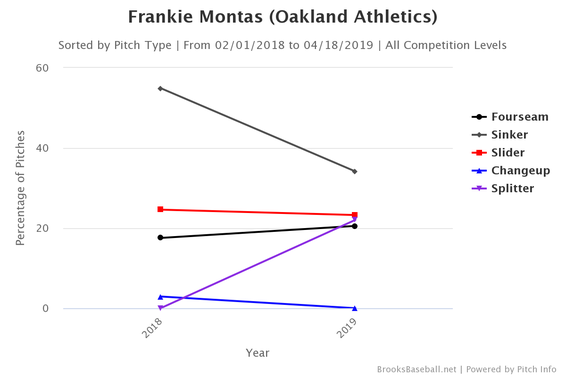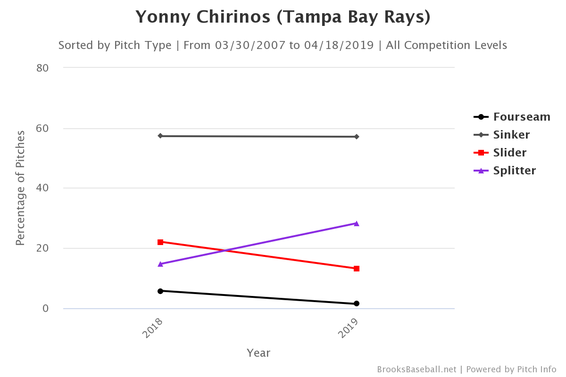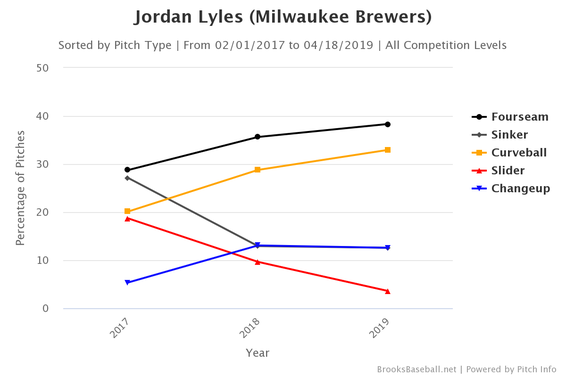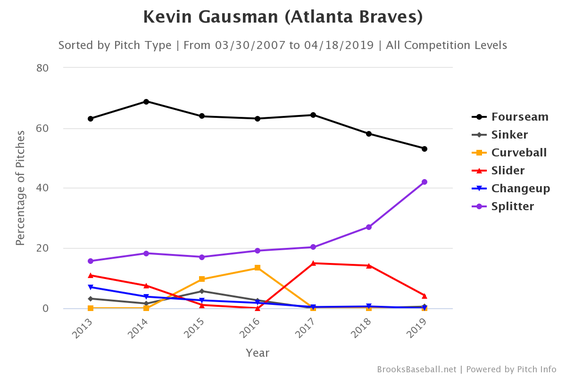Fantasy Baseball: Five pitchers making changes that could propel them to stardom
Looking for early-season breakouts you can trust? Aaron Sauceda dives into changes five pitchers have made that could propel them to stardom.
Editor's Note: This piece references Aaron Sauceda's ACES metric, a new way to assess pitchers by their stuff, and a new way to find Fantasy values or potential busts. For an introduction to the metric and why it matters, go here. To see the full results of this metric, go to SportsLine now, use promo code "SCORE" to get half off all of their exclusive Fantasy content now.
I've had the pleasure of making some bad moves early in the season. In 2017, it was "selling high" on some Yankees prospect named Luis Severino off to a hot start — you know, the one who went on to pitch 193 innings, strikeout 230 batters and finish with an ERA under 3.00.
It was a deep league with once-per-month waiver adds and my only second basement got hurt. It felt like great value at the time to trade him for Ian Kinsler — who's ADP was nearly a couple hundred picks higher just weeks before and was fresh off a season where he hit .288, 28 HR, 117 runs, 83 RBI and 14 SB.
The year before that, it was, again, "selling high" on the eventual AL CY Young and 22-game winner, Rick Porcello.
It can be hard to exercise patience in the early going — we want to make moves, dang it! But many of the stats we play for are still incubating, not yet fully ready to be acted upon. We're barely to the point where even the stats that become meaningful earliest, such as strikeouts, are useful.
Still, everyday more games are being played, more data is being collected and we're (hopefully) getting smarter about how this season will play out. While we need to be methodical and calculated —particularly early on — sitting back for too long is not the right approach either. Surely there are some things we should be acting upon!
Let's look at some of those things for starting pitchers — things that we think might be predictive of rest-of-season performance. Specifically, we can detect pitcher improvements early in the season by looking at the following three things:
- New pitches
- Improved pitches (e.g., add velocity, movement and/or command)
- Improved mix of pitches (e.g., throw good pitches more, bad pitches less)
While pitching is never that simple — and there are other things we could assess — that's our early season rubric.
By this rubric, here are five starting pitchers that are doing interesting things so far — four worth buying at their respective costs and one to file away on your watch list.
No pitcher has increased their usage of one pitch more than Montas. Of course, that's referencing his new splitter:

The splitter usage is largely coming at the expense of his sinker, a pitch that flashed plus stuff last season (94th percentile by ACES) but generated average whiffs and below average groundballs. Even better, the splitter flashes above average velocity and elite drop:
Measure | Value | Percentile |
Velo | 86.6 | 60% |
H Mov | -6.12 | 40% |
V Mov | 0.78 | 93% |
It's a small sample (55 splitters thrown) but it's also generating results with a 20% whiff that ranks in the top third among splitters. While it's an intriguing change, command is likely to be a barrier to larger success — as a prospect, his command graded as below average. That said, he did seem to improve in that respect as he rated roughly league average last season by Command+.
Also, let's not forget — Montas' stuff popped last season, with anarsenal rated 88th percentile by ACES. He's now throwing four pitches more than 20% of the time, creating an incredibly balanced arsenal that should help him reduce his times through the order penalty (TTOP).
Putting it all together, we have a relatively young pitcher, who's added a promising new pitch to an already-intriguing arsenal, pitching in a pitcher's paradise and for a good team. I'll easily take the under on his Steamer projections (4.57 ERA) and bet on something much closer to a high-threes or low-fours ERA.
Eno Sarris wrote an excellent piece ($) on Chirinos this past offseason, highlighting him as a name who could surprise by repeating what he did last season (3.51 ERA). So far, so good. Specifically, there are two things in his favor to date.
First, his fastball velocity is up more than a tick from where it was in April of last year. Second, he's reduced his slider usage in favor of his superior splitter:

That's a change worth noting when your results look like this (2018):
| Sinker | Slider | Splitter |
Frequency | 55% | 20% | 21% |
PERCENTILES: | | | |
ACES | 90% | 55% | 94% |
Whiffs | 82% | 62% | 83% |
GB+PU% | 42% | 6% | 50% |
Some may not want the "headache" of dealing with the Rays opener — you might not always know exactly when he's going to "start," at least to the same degree as a traditional starter. But as long as you play in leagues that count wins — not quality starts — the Rays opener system might actually make Chirinos more intriguing, particularly with how strong the Rays have looked so far (best record and run differential in the league as of this writing). Ryan Yarbrough picked up 16 wins in a similar role last season, good for second most on the team behind Blake Snell's 21.
With Chirinos already flashing 76th percentile stuff by ACES last season and emphasizing his best pitch even more, this is a situation I want exposure to.
We touched on Lyles before the season — both on the podcast and as an honorable mention on our pitching sleepers column — citing his 92nd percentile stuff by ACES as a case for intrigue. There was also some buzz that he might wrestle the fifth starting job away from Nick Kingham but nothing was definitive at the time.
Since that time, Lyles has indeed won the fifth starting job and has played quite well, currently sporting a 28.6% strikeout rate. What's interesting is the path that Lyles is taking to get there.
Lance Brozdowski of Prospects Live and Razzball was one of the first to notice, tweeting that Lyles is reducing his usage of the slider and emphasizing his curve more:

As is a running theme with the others on this list, it's great to see pitchers throw more of their pitches that work well and fewer of those that don't. Look at Lyles repertoire — and that curve — from 2018 and you can get a sense pretty quickly that this is a change we'll gladly welcome:
| Fourseam | Sinker | Curve | Slider | Change |
Frequency | 36% | 14% | 27% | 11% | 11% |
PERCENTILES: | | | | | |
ACES | 90% | 90% | 98% | 87% | 71% |
Whiffs | 24% | 46% | 77% | 5% | 25% |
GB+PU% | 34% | 80% | 96% | 2% | 72% |
While it's great to see Lyles throwing his curve more, it's also worth noting that his 92nd percentile stuff by ACES last year was a bit inflated by his role coming out of the bullpen, which enabled a higher velocity. As expected, his fastball velocity is down a tick from where it was in May of last year. And while fifth starters can drive you crazy at times — like when they get their turn in the rotation occasionally skipped — don't sleep on Lyles. Now perhaps he should consider throwing his sinker more often instead of his fourseam fastball …
Wheeler doesn't fit in with the rest of this list. Just weeks ago in drafts — feels like an eternity, I know — his ADP was hundreds of picks higher than the other guys here. But he hasn't been good so far (6.35 ERA).
Then again, it's been just four starts and 22.2 innings. More importantly, his fastball velocity (97) is three ticks higher than it was during April last year. WHOA.
In fact, even though velocity tends to peak in August, Wheeler is averaging more of it across the board than he was all of last year:

That's a great sign for someone who rated as 97th percentile by ACES last season and possesses stuff like this (from 2018):
| Fourseam | Curve | Slider | Change | Splitter |
Frequency | 58% | 11% | 19% | 6% | 6% |
PERCENTILES: | | | | | |
ACES | 98% | 78% | 82% | 85% | 99% |
Whiffs | 81% | 77% | 31% | 38% | 50% |
GB+PU% | 90% | 21% | 89% | 6% | 0% |
If the Wheeler owner in your league is starting to have doubts about their investment, make sure you're one of their first calls.
Gausman is doing something interesting:

Not all changes are obviously positive changes — he's basically morphing into a two-pitch pitcher, cutting his slider in favor of more splitters. Yet, when looking at his arsenal from 2018, you can start to understand why:
| Fourseam | Slider | Splitter |
Frequency | 58% | 14% | 27% |
PERCENTILES: | | | |
ACES | 93% | 41% | 96% |
Whiffs | 50% | 35% | 61% |
GB+PU% | 63% | 58% | 89% |
His fourseam and splitter were both elite by velocity, movement and command (ACES). Relying on two pitches raises fair concerns about his ability to turn over the lineup — while his slider wasn't great, it at least served as a "show me" third pitch to keep from being too predictable — but there's something intriguing about throwing your best pitches more and your weaker ones less.
Despite early success, he's proved nothing so far — as far as you can "prove" anything in a four-game sample — particularly when you consider two of his first three opponents have included games against the hapless Marlins and the Goldy-less Diamondbacks. That said, keep a close eye on Gausman and how his pitch mix shift plays out.
How should we play it with these names? For those in shallower leagues, don't forget about them as you build your watch lists and scour your waivers wires. In deeper leagues, perhaps one of these guys are still available. If you're hammering out trades, think about adding them as a potential throw-in to your side of the deal. They may not be the sexiest names, but they're making interesting changes that are worth watching on your team — not your league mates.
















